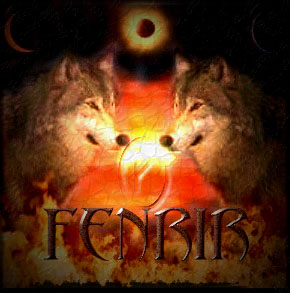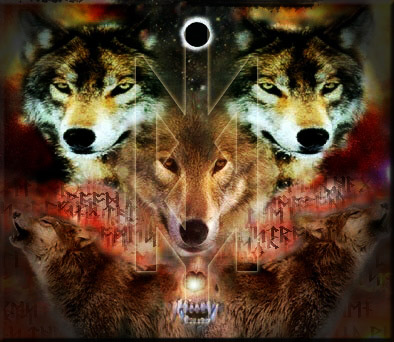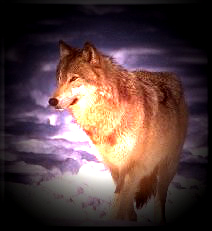Bonds all break,
The wolf runs free
Of all of Loki's children, it is Fenrir
who until now has maintained an enigmatic, and elusive
position; his status as mere monster has not befitted
his with those attributes that goddesshood gives Hela,
or that mythological familiarity has given Iormungand.
And yet, Fenrir has found his followers in those who identify
with his violent and restless character; even when this
appeal seems more motivated by a vacuous love of violence
than any real understanding of his nature.
Fenrir is the lupine child of Loki and
Angrboda, and he is the manifestation of unadulterated
masculine energy in Rökkr kozmology. His most frequent
form is that of a wolf, a wolf so monstrous that when
he opens his mouth, his jaws reach to both Heaven and
Earth. Following his birth the Æsir realised the
threat that Fenrir posed to them and to kozmic order,
so at first they sort to restrain him through affection.
Tiwaz, the original god of war, befriended the young pup,
and feed him. But as Fenrir steadily grew, the Æsir's
attempt at over riding his fundamentally Rökkr nature
failed, and they were left with no alternative but to
try and chain his. The gods attempted to chain him with
a chain called Laeding, and then with one called Dromi,
but Fenrir broke both of them easily. The Svartalfar were
then employed to forge the strongest of all chains in
the kozmos, and so they created a silken bond called Gleipner,
made from:
- the sound of a cat's paw
- the hairs of a maiden's beard
- the roots of a mountain
- the dreams of a bear
- the breath of a fish
- the spittle of a bird
These items are all intangible objects, on Earth at least, and since they do not exist, the bond could not be broken by anyone or anything, other than at the appropriate time; that time being Ragnarok. Essentially, Gleipner was forged out of Wyrd, and is permeated by that kozmic force. It has the same intangible unknowable characteristics as Wyrd itself, and as Wyrd is beyond any definitive definition, so too it would be impossible to ever acquire the items from which Gleipner was made. Thus, because the bond was forged from Wyrd, it has a set purpose, and a set time allowed, which is dependent upon the whim of Wyrd only.
The Æsir gods persuaded Fenrir to
go with them to Lyngvi, a desolate island in the middle
of Lake Amsvartinar, The Gulf of Black Grief. Here
they asked Fenrir if he would let them try to bind him
one more. He warily agreed, but only on the condition
that one of the gods put their hand into his mouth as
a matter of honour, and so ensure he would be released
if he failed this test of strength. Only Tiwaz had the
courage, and the honour, to accept the Wolf's conditions,
and so when the Æsir gods dishonoured their
agreement, and failed to release Fenrir, Tiwaz's right
hand was bitten off. With Fenrir now bound by Gleipner,
the magickal bond was attached to a chain called Gelgia,
which was pushed into a hole in a massive rock sunk deep
in the earth called Gjall. As a final indignity, Fenrir's
mouth was prised open with a sword, and there he remained
until Ragnarok. Blood and saliva flowed from the open
jaws of Fenrir, and this formed the great rushing river
of Von, with its two stream of Wil and Wan.
At Ragnarok Fenrir was indeed unleashed,
and as Wyrd broke his chain, he ran onto the plain of
Vigrid, where he killed his blood-uncle and nemesis, Odin;
as it is written in the Voluspa: for there dies Frigg's
delight. However, Fenrir suffered retribution too, and
was killed by Odin's vengeful son Vidar, who tore his
jaws asunder, and drove his spear into his heart.

Fenrir himself was not childless, for in
the times before he was bound, he had fathered the wolfen
children of Angrboda, the Hag of Ironwood (the forest
east of Midgard). They were called Hati and Skoll, and
were the wolves who pursued the sun and moon respectively.
Hati's attacks on the moon in particular are seen every
month as it waxes and wanes. Finally, at Ragnarok, in
the sky above the Vigrid field, they both captured and
devoured their goals. Neither of them is listed amongst
the dead of Ragnarok, and so it could be conjectured that
they live on into the Regeneration of the world.
Fenrir, like the Wolf's Hook Cross, is
a representation of unchangeable fate. There is an aura
of fatality surrounding him that the gods sense, and none
more so than Odin, because it is primarily his existence
which is subject to Fenrir's whim. Odin, having heard
the prophecies of the Volva (Fenrir's own mother, Angrboda)
knew that his son Balder would be slain, that his brother
Hodur would do this act. That the Rökkr forces would
break free of their bonds, and destroy the gods. And that
finally he, Odin, would die within the massive jaws of
Fenrir.
Thus, the binding of Fenrir with Gleipner is nothing but a postponement of the inevitable. It is merely an instance of the gods, and Odin in particular, performing, and realizing, their role. For, although the Fate incurred by Fenrir may be unavoidable and unchangeable, it does not necessarily mean defeat or resignation. One of the great lessons of the Rökkr is that this life is nothing, that there is no integral meaning to it, and that it can all so easily be consumed by Fenrir. The purpose of living, then, is to realize this truth, and then to build ones own worth and meaning from existence.
The scene of Fenrir threatening kozmic
stability was represented in the northern skies by the
constellation of the Greater Wolf's Jaw; a stellar array
comprised of stars from the constellations of Cygnus,
Pegasus, and Andromeda. This constellation gapes menacingly
towards the pole star, with the twin tails of the Milky
Way appearing as the two rivers of saliva which flowed
from Fenrir's mouth.
This idea of a kozmic wolf is not limited to Rökkr kozmology, and appears across Europe and Asia, and even in the Americas. In the myths of the Slavic and Baltic regions, a wolf that would eventually destroy the world was chained to the centre of the heavens, the Pole Star, by the Zorya, the triple aspect goddess of fate (known by a number of various names throughout Eastern Europe). The wolf would eventually be released from its iron chain, to do the will of the Goddess and consume the world. This wolf was symbolized by the constellation of Ursa Minor, which is seen as the second wagon of Hela in the Northern Tradition. Because the star Polaris is the tail of Ursa Minor, it depicts the tail of the Slavic wolf, attached to the hub of the heavens.
This lupine connection to Ursa Minor, and the continuation of kozmic order, is further compounded by the philosophy of a Greek sect, the Cynics, founded by Antisthenes (a pupil of Socrates) and his follower, the sage Diogenes of Sinope. The Cynics regarded themselves as the watchdogs of the goddess, their name coming from the Greek word kynikos, meaning dog-like ones. They would observe the Polaris star, which they knew as Kynos Oura (The Dog's Tail), and believed that when the star began to move from its home (ergo: when the dog was unleashed) the end of the world would be imminent. That Ursa Minor was the cynosure (literally, the centre of attraction) for the Cynics, makes an interesting reference to the Cretan stellar goddess Cynosura, from which the word derives, whose constellation was likewise Ursa Minor.
Similarly, in the mythology of the Kirghiz, the seven stars of Ursa Major were visualized as a group of guards who watched over the two brightest stars of Ursa Minor, who were represented by two horses, from a kozmic wolf. The day when the two horses are finally killed by the wolf is the day the world ends.
The concept of a kozmic wolf was essential to the expansion of the Mongolian Empire, because they believed they descended from the azure-blue wolf Eternal Blue Heaven, who represented the vault of the sky. This divine ancestry provided a mandate for Genghis Khan's empire, and for this reason, the Mongols referred to themselves as Blue Mongols. The Mongols are related to older Turkic-speaking peoples, who also featured the tradition of an azure sky wolf, and their shamanism is linked to forms in the American continents (and Rökkr shamanism) where the wolf is seen too. In Cheyenne magick, for example, the ancestral wolf was seen as the star of Aldebaran, while his consort, a white wolf, was represented by Sirius.
Fenrir corresponds to the planet of Mercury, and sitting as he does opposite the Feminine sphere of Venus, Fenrir is the embodiment of pure Masculine force in the kozmos. This is the all-pervasive, unrestrained force, which operates as a function of the polarity of the kozmos.
CORRESPONDENCES OF FENRIR
Rune: Wolf’s Hook Rune
Herb: Wolfsbane
Tree: Yew
Stone: Tourmaline
Animals: Wolf
Colour: Blue-black
Element: Air
Planet: Mercury
Direction: West
Body Point: Throat
Constellations: Greater Wolf’s Jaw

A VISION OF FENRIR
The door opens with a mountain in the distance framing my view.
Beneath it lies a lush green forest.
Beside the forest runs a pure blue river.
The Sun is bright, hanging high in the sky.
Suddenly the picture changes.
The river runs red with blood.
Dismembered bodies float towards me through the bloody tide.
High in the sky, the huge head of Fenrir appears.
Jaws widening, he grasps the sun and consumes it.
Like a rapid twilight, the sky darkens.
All that remains beneath the blackened sky is a band of silver,
lying across the horizon.
* * *
.

|

